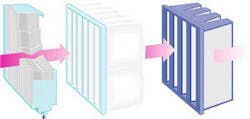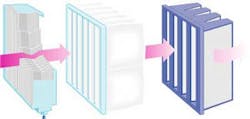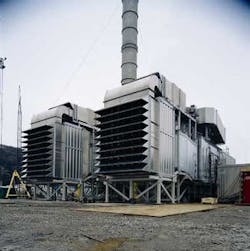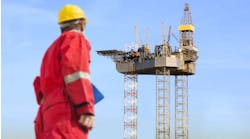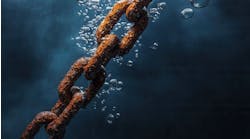Offshore platforms and other marine installations are examples of environments where external stresses make harsh demands on equipment. The ocean air is filled with moisture and salt, both of which must be controlled (removed) to get maximum performance from rotating equipment. The equipment must be fully operational at all times under both normal and extreme conditions. Every unplanned shutdown causes a loss of production income and results in expensive repairs for breakdowns.
Rotating machinery used for power generation or for driving other mechanical equipment is intrinsically noisy. Such equipment also depends on clean air to perform as expected. Camfil Industrifilter, the Swedish subsidiary of Camfil Farr, has been delivering gas turbine air inlet filtration systems for over twenty-five years as well as producing acoustic enclosures, inlet and outlet (exhaust) silencers to protect the machinery's surroundings from noise emissions.
Sound suppression
The enclosures are designed to reduce the high noise level from the machinery as well as protect the same from environmental loads and people from hazards. Turbines have high frequency sounds while compressors and engines have lower frequency noise control needs. For inlet systems, the silencer elements are designed so that:
- Noise reduction is optimized
- Pressure drop is minimized for minimum efficiency and power loss.
The exhaust system must attenuate low-frequency noise, be able to withstand high vibration and high thermal stresses. Most exhaust systems are made of heat-resistant steel, so that the noise attenuating elements can withstand high temperatures without degradation.
The ventilation systems are fitted with filters, fire dampers, and silencers. They are normally supplied with back-up fans and backdraft dampers to ensure continuous operation.
High-efficiency filtration
The company also produces high specification filters to capture dust and salt particles that can erode and degrade rotating equipment. To clean intake air in harsh, wet environments, Camfil developed the CamGT filter. This patented high capacity filter has a rigid design supported by a downstream screen, a unique vertically pleated filter media for water drainage and has a low pressure drop in high humidity conditions. The filter captures both dry particles and salt brines without leaking.
Filter pleats and a slight tilt allow brine to drain and collect so it can be removed. The sealed frame prevents air bypass while the vertical pleats yield a stable pressure drop across the filter. Of special note is the patented pleating technique with intermittent glue strings at the front of the media pack. This permits the base to remain open so brine drainage is easily accommodated.
The filter system has been well received since its first installation in 1998. That was on the Saga Vigdis, a satellite to Snorre A in the North Sea. Because of its wide acceptance, the filter replacement market is expanding. To date over 10,000 filters have been delivered.
Filter exchange is simplified by standard filter sizes and the filter tilt can be adapted to the application for proper brine drainage. The filter is also completely incinerable which makes disposal easy and clean.
Filter housings can be produced from stainless steel, carbon steel, or marine grade aluminum. Stainless steel is excellent for corrosive environments, but is heavy. By using aluminum, a weight savings of up to 40% is possible. For weight-constrained platforms, this means that on typical gas turbine package, 10-15 tons per unit can be saved for other facilities equipment.
Current activity
This year, Camfil Industrifilter, is delivering many units for the North Sea (Grane for Norsk Hydro, Valhall for BP and Kvitebjorn for Statoil). Customers are GE-Norway and Dresser-Rand. Parent company Camfil Farr, with its world-wide presence, has a reputation in turbine filtration and sound control systems for turbine-driven generator and compressor sets for offshore power applications. Last year, the company's US subsidiary was kept busy by Pemex, which needed 11 units for various field installations.
Following the BP-Valhall a new major contract was recently signed with Dresser-Rand. For BP's Gulf of Mexico deepwater project, Camfil Farr was the selected supplier. This took place after extensive salt performance testing of the CamGT, together with BP/D-R, at Camfil Farr's R&D testing facilities at corporate headquarters in Trosa, Sweden. The first project will be the Holstein platform with three turbines, to be followed by Crazy Horse with five turbines. Planned to follow are Mad Dog and Atlantis. The turbines, GE-LM2500+, will be packaged by Dresser-Rand, Kongsberg Norway, while Camfil Farr will deliver the complete air filtration and acoustic control systems. Materials are aluminum and stainless steel.
First delivery is scheduled for the end of October 2001 with others to follow throughout the next year. In addition, offshore units are currently built for Alstom Power, GT35 for Middle East project.
Offshore installations are a large part of Camfil Farr's gas turbine activity, however most of the installations are onshore. A total of fifteen 60-MW units are on order for gas turbine power generation - for continuous duty and for peaking power. New opportunities continue to present themselves.
For more information, contact Peter Sandberg, Camfil Indusrifilter: Tel:+46 33 17 85 00, Fax: +46 33 17 85 55, e-mail: [email protected] or Steve Mickool, Camfil Farr (Houston): Tel:+1-281-850-8416, Fax: 281-338-0854, or e-mail: [email protected].
